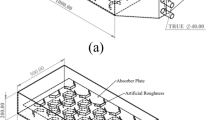Abstract
In this paper, an experimental comparison of the thermal performances of the sundried earth bricks building and parpen brick building have been carried out. For this purpose, an electrical model of the building was elaborated and an experimental set-up was constructed. Measured temperatures and relative humidity from sundried earth bricks and parpen buildings were compared and the numerical simulation results were validated against experimental results statically. Our findings reveal that, building constructed with sundried earth bricks present good energy performances compared to parpen bricks building with 40–60% versus 10–40% relative humidity and 24°C versus 29°C temperature, respectively. Moreover, the numerical and experimental results were found to be in good agreement. Maximum absolute percentage error, maximum absolute error and absolute percentage error of 3.4%, 0.66°C and 6.4%, were obtained respectively. Sundried earth block was recommended for construction and the electrical model was proposed for the prediction of the thermal behavior of buildings.






















Similar content being viewed by others
Abbreviations
- APE:
-
Absolute Percentage Error
- MAE:
-
Maximum Absolute Error
- MAPE:
-
Maximum Absolute Percentage Error
- ASHRAE:
-
American Society for Heating, Refrigerating and Air-conditioning Engineering
- BESTEST:
-
Building Energy Simulation Test
- CoDyBA:
-
Code de simulation Dynamique du Batiment
- CFD:
-
Computational Fluid Dynamics
- ECBCS:
-
Energy Conservation in Buildings and Community Systems
- HAM:
-
Heat, Air and Moisture
- HAMSTAD:
-
Heat, Air and Moisture Standards Development
- HVAC:
-
Heating Ventilating and Air Conditioning
- IEA:
-
International Energy Agency
- ISO:
-
International Standard Organization
- TRNSYS:
-
Transient System Simulation
References
Fohagui F C V and Tchuen G 2017 The determination of the most economical combination between external wall and the optimum insulation material in Cameroonian’s buildings. J. Build. Eng. 9: 155–163
Fohagui F C V, Tchuen G and Tchitnga R 2017 Influence of the types of fuel and building material on energy savings into building in tropical region of Cameroon. Appl. Therm. Eng. 122: 806–819
Fohagui F C V, 2019 Contribution to the improvement of the thermal performances of buildings in some regions of Cameroon. PhD thesis. Faculty of Science. University of Dschang
Zairi A and Mokhtari A 2010 Modélisation du comportement thermique des locaux sous différentes configurations avec le sol par l’analyse modale. J. Sci. Res. 1: 1–7
1993 Conception thermo-aéraulique de bâtiments multizones. Proposition d’un outil à choix multiple des modèles, Mechanics, INSA de Lyon
Asan H 2006 Numerical computation of time lags and decrement factors for different building materials. Build. and Env. 41: 615–620
Al-Sanea S A and Zedan M F 2011 Improving thermal performance of building walls by optimizing insulation layer distribution and thickness for same thermal mass. Appl. Energy. 88: 3113–3124
Threlkeld J L 1970 Thermal environmental engineering. Prentice-Hall, Englewood Cliffs, NJ, pp 102–106
IEA 2009, Task 34 - Testing and Validation of Building Energy Simulation Tools (BESTEST), Solar Heating & Cooling Program. Available from: http://www.iea-shc.org/publications/category.aspx?CategoryID=39
Roels S, Carmeliet J and Hens H, 2003 HAMSTAD WP1: Final report – Moisture transfer properties and materials characterization. Laboratory of Building Physics. KU Leuven
Abdelkrim T, Rafik B and Menghao Q 2010 Transferts couplés de chaleur and d’humidité dans les bâtiments climatisés. J. Mat. Sci. 47: 3655–3663
Kemajou A and Mba L 2012 Real impact of the thermal inertia on the internal ambient temperature of the building in the hot humid climate: simulation and experimental study in the city of Douala in Cameroon. IJJRRAS 11: 358–367
Van Belleghem M, Steeman M, Janssens A and De Paepe M, 2011 Validation of a coupled CFD‐HAM model with a climate chamber experiment on a small wall sample. In: Proceedings of the 9th Nordic Symposium on Building Physics, NSB2011, Department of Civil Engineering, Tampere University of Technology, Tampere, Finland: 1, ISBN 978‐952‐15‐2574‐2, pp. 1-6
Xavier F, 2007 Optimisation d’enveloppe hybride pour bâtiment à haute performance énergétique. Thèse de doctorat en physique. Université Joseph Fourier, France
Bekkouche S M A, Benouaz T, Cherier M K, Hamdani M, Yaiche M R and Benamrane N 2013 Influence of the compactness index to increase the internal temperature of a building in Saharan climate. Energy Build. 66: 678–687
Mokhtari F, Ait Messaoudène N, Hamid A and Belhamel M 2006 Etude du comportement thermique d’une maison munie d’un système de chauffage solaire. Rev. Energies Ren. 9: 363–370
ASHRAE 2009, Handbook-Fundamentals. American Society of Heating Refrigerating and Air-conditioning Engineers. Inc
ASHRAE 2013 ASHRAE Standard 55: Thermal Environmental Conditions for Human Occupancy. American Society of Heating, Refrigerating and Air-Conditioning Engineers, Atlanta, GA
ISO 2005 Ergonomics of the Thermal Environment – Analytical Determination and Interpretation of Thermal Comfort Using Calculation of the PMV and PPD Indices and Local Thermal Comfort Criteria, ISO. 7730: Geneva
Cabeza L F, Castell A, Medrano M, Martorell I, Perez G and Fernandez I 2010 Experimental study on the performance of insulation materials in Mediterranean construction. Energy Build. 42: 630–636
Wu S and Sun J Q 2012 A physics-based linear parametric model of room temperature in office buildings. Build. Env. 50: 1–9
Author information
Authors and Affiliations
Corresponding author
Rights and permissions
About this article
Cite this article
Fohagui, F.C.V., Koholé, Y.W. & Tchuen, G. Experimental comparison of energy performances of common types of buildings constructed in Cameroon and validation of their electrical model. Sādhanā 46, 159 (2021). https://doi.org/10.1007/s12046-021-01670-9
Received:
Revised:
Accepted:
Published:
DOI: https://doi.org/10.1007/s12046-021-01670-9




